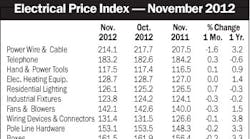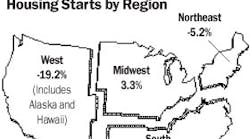Latest from Mag
People - Dec 21, 2012
Obituaries - Dec 21, 2012
November EPI Index Shows No Change
Housing Starts Dip 4% in November
Electrical Marketing - December 21, 2012
Around the Industry - Dec 21, 2012
Despite the absence of several key exhibitors and fewer attendees than past shows, last week’s LightFair 2004 proved why it reigns supreme as the king of the lighting shows.
Several long-time attendees and exhibitors at LightFair, held March 31-April 2 at the Las Vegas Convention Center, Las Vegas, said attendance at the show seemed lighter than usual, with fewer lighting designers and architects. They also said more reps were prowling the aisles for new product lines than at previous shows.
Notable in their absence on the show floor were Philips Lighting Co., Somerset, N.J.; Advance Transformer Co., Rosemont, Ill.; and the Genlyte Thomas companies. Philips and Advance Transformer opted for off-site exhibits at the Bellagio Hotel. Osram Sylvania, Danvers, Mass., which in past years would have one of the larger exhibits at LightFair, had a much smaller presence. Only one Osram company, Osram Opto Semiconductors Inc., San Jose, a manufacturer of light-emitting diodes (LEDs), had a booth at the show.
However, LightFair is still the lighting industry’s annual “meeting of the tribes,” a venue where designers, architects, reps, distributors and other lighting professionals can network, learn what’s new in the market and learn about lighting. At this year’s LightFair, several dozen lighting classes offered continuing education units (CEUs), and dozens of new product introductions.
Although LEDs continue to capture the imagination of the lighting community, they are already widely used in the emergency lighting and signage markets. However, LEDs are still years away from cost-effectively producing the white light necessary for general lighting applications. Many exhibitors featured LED-powered fixtures with wall and ceiling panels that allow designers to literally paint applications with light in an ever-changing array of dazzling color schemes.
At least seven LED-powered products won either “Best of Category” or “Best Overall” awards in LightFair’s annual New Product Showcase Awards, which attracted 222 entries. (See full listing of winners in related article on this page.) The Line luminaire manufactured by io Lighting, Melrose Park, Ill., won Best New Product of the Year; the LED flood by Enlux, Mesa, Ariz., won the Energy Award; VersaTILE from Element Labs Inc., Austin, Texas, won the Roeder Award; and Mood Light Objects from Traxon USA, New York, captured the Judges’ Citation Award.
There was renewed interest in energy efficiency at LightFair because of next year’s national adoption of the ANSI/ASHRAE/IESNA Standard 90.1 for the design of energy-efficient buildings. Because of the standard’s stringent requirements for the lighting power density units used in designing electrical systems for nonresidential applications, manufacturers were promoting products that would help engineers and lighting designers comply with these standards.
While many of the new products exhibited at LightFair were aimed at the high end of the architectural lighting market and were therefore outside the mainstream of the electrical wholesaling industry, many new products at the show were designed for commercial lighting applications.
Juno Lighting Group, Des Plaines, Ill., unveiled its ModuLight system, which converts Class 1 line voltage into Class 3 power limited (National Electrical Code Article 25). This technological advance eliminates conduit, standard wiring, whips and junction boxes. The ModuLight system uses T8 fluorescent and compact fluorescent lamps and is installed with a quick-connect cabling system.
Miniature metal-halide lamps with major energy-saving capabilities were introduced by Philips Lighting Co. and GE Lighting, Nela Park, Ohio. The Philips 20W Mini MasterColor metal-halide lamp replaces 60W halogen lamps and is promoted as being 50 percent smaller than competitive products. GE Lighting exhibited its CMH 20W PAR20 and CMH 20W PAR30 metal-halide lamps, which it says provide up to twice the light output, up to three times the rated life, and as little as half the energy consumption of halogen lamps.
Another intriguing new product is the EFO fiber-optic lighting system by Fiberstars, Fremont, Calif. EFO transmits light from a centralized lighting “illuminator” through fiber-optic cables to up to six fixtures. The company says a single 75W EFO illuminator can provide six lighting fixtures with the same lumens output as a 50W halogen fixture, saving over 225W for a six-fixture installation.

